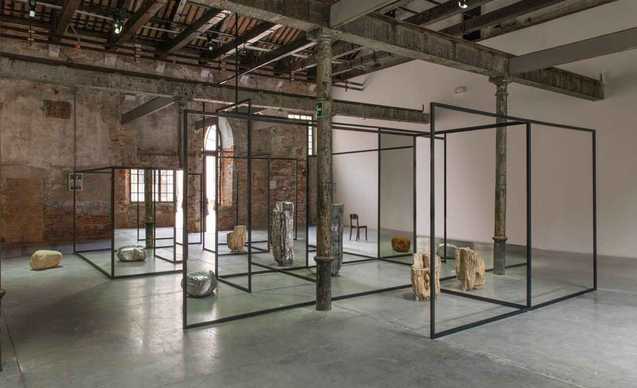Alicjia Kwade
opere dalla collezione Sandretto a palazzo Biscari
Works from the Sandretto Re Rebaudengo Collection at Palazzo Biscari
Curated by Ludovico Pratesi and Pietro Scammacca
Ballroom: WeltenLinie (2017)by Alicja Kwade (08.07.19 – 24.08.19)
Eastern Wing Apartments: The analogous room, group show (08.07.19 – 07.07.19)
Palazzo Biscari, via Museo Biscari, 10 – 95131 – Catania
On July 8, 2019 Palazzo Biscari will reopen its doors to contemporary art, hosting a selection of work from the prestigious Sandretto Re Rebaudengo Collection. The project, curated by Ludovico Pratesi and Pietro Scammacca, occupies two parts of the palace: an environmental installation by the artist Alicja Kwade in the Ballroom (open until August 24, 2019), and a group exhibition titled “The analogous room” in the Eastern wing apartments, open to the public for the first time (until September 7, 2019).
WeltenLinie (2017) by Alicja Kwade is a composition made of mirrors and steel frames, produced by the Sandretto Re Rebaudengo Foundation on the occasion of the 57th Venice Biennale. The work animates an environment constructed from ambiguous reflections in which objects multiply and appear to be set in motion, in the process seemingly transforming space into temporal matter. Its presentation in the alchemical space of Palazzo Biscari’s Ballroom establishes an evocative dialogue with the ornamental interiors of the palace, and resonates with the illuminist and esoteric visions of its most illustrious inhabitant: Ignazio Paternò Castello, V Prince of Biscari. A polyhedral figure, responsible for numerous archeological findings in Sicily, Paternò Castello also created a vegetal labyrinth which acted as thse public garden of the city of Catania until the mid-nineteenth century. In this context, Kwade’s environment becomes a sort of "baroque machine" that reconfigures the viewer's relationship with reality. In dialogue with the mirrors of the Ballroom and the many trompe l'oeil that decorate the walls, Kwade's installation plunges the visitor into a kaleidoscopic and labyrinthine space of perception.
The Eastern Wing apartments host the group show “The analogous room,” which acts as an echo of a particular space in Palazzo Biscari: a room named after Don Quixote and decorated with twelve paintings depicting scenes from the journeys of Cervantes' picaresque character. The exhibition brings together twenty artists from the Collection from different generations that have carried out a critique of representation in different languages and mediums. Similar to narrative devices found in Cervantes' novel—such as the destabilization of authorship and authenticity, which anticipate strategies in art of the late twentieth-century—the works explore different structures of meaning and signification, questioning the legitimacy of knowledge and truth. Like Don Quixote, the artists move along a thin line that separates reality from fiction: 'alienated in analogy', they become 'the disordered players of the Same and the Other', to quote observations by Michel Foucault. The “Don Quixote room” is inaccessible to visitors, but is alluded to by the arrangement of work to become present in their imaginations, thus acting as a starting point for the exhibition. This creates an analogy between the physical but unseen space of the eighteenth-century room, and the conceptual but perceptible space of the exhibition.
In hosting a private collection, the palace seeks to create connections with its prior role as host, beginning in the 18th century, to a museum of archaeological findings, scientific instruments, and natural rarities belonging to the collection of Ignazio Paternò Castello, V, which occupied the rooms of the Biscari Museum until the last century. The exhibition is accompanied by a didactic program organized by the educational department of the Sandretto Re Rebaudengo Foundation which will train a group of students from the University of Catania to become cultural mediators of the exhibition.
The project was carried out in collaboration with the Sandretto Re Rebaudengo Foundation and UNFOLD. We thank Palazzo Biscari, Fondazione Sicilia, Dusty, Murgo Winery, and Radice Pura for their generous support for to this project.
Exhibited artists: Ballroom: Alicja Kwade
Eastern Wing appartments: Ludovica Carbotta, James Casebere, Roberto Cuoghi, Flavio Favelli, Katharina Fritsch, Anna Gaskell, Dominique Gonzalez-Foerster, Douglas Gordon, Pierre Huyghe, Louise Lawler, Renato Leotta, Sherrie Levine, Katya Novitskova, Tony Oursler, Philippe Parreno, Nicolas Party, Paul Pfeiffer, Laure Prouvost, Magali Reus, David Shrigley
